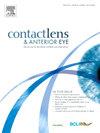Translation and validation of the 8-item contact lens dry eye questionnaire (CLDEQ-8) among Chinese soft contact lens wearers
IF 4.1
3区 医学
Q1 OPHTHALMOLOGY
引用次数: 0
Abstract
Purpose
To develop a Chinese version of the 8-item Contact Lens Dry Eye Questionnaire (CLDEQ-8) with cross-cultural adaption and clinical validation among soft contact lens wearers (SCL) in China.
Methods
The translation and adaptation of the Chinese CLDEQ-8 (C-CLDEQ-8) followed a rigorous methodological process based on cross-cultural research guidelines consisting of three main phases: 1) forward and backward translation of original CLDEQ-8 into Chinese, 2) cross-cultural adaptation performed by medical advising committee, and 3) clinical validation and repeatability test of the translated questionnaire on Chinese SCL wearers. Rasch analysis was also performed to investigate the psychometric properties of C-CLDEQ-8.
Results
134 experienced SCL wearers aged 18–45 completed the C-CLDEQ-8. C-CLDEQ-8 score was linearly related to the overall opinion of SCLs (beta = 2.16, p = 0.002), gestalt eye dryness response (beta = 2.90, p < 0.001), and sensitivity response (beta = 1.83, p = 0.001). The questionnaire showed excellent test–retest repeatability with an intra-class correlation coefficient (ICC) of 0.95 and great internal consistency with a Cronbach’s alpha of 0.83. The corrected index of homogeneity for each item was more significant than 0.5. In Rasch analysis, the infit and outfit values for eight items were all within 0.6–1.4, suggesting a good fit for the Rasch model. Martin-Löf test result indicated that the Rasch model was unidimensional (p = 1.0). Item characteristics curves suggested combining categories 3–4 and 5–6 in item 5 of C-CLDEQ-8.
Conclusions
This study produced a Chinese version of CLDEQ-8 with great validity and reliability and proved capable of evaluating SCL-related symptoms.
在中国软性隐形眼镜佩戴者中翻译和验证隐形眼镜干眼症调查问卷(CLDEQ-8)。
目的:编制中国软性隐形眼镜配戴者8项干眼症问卷(CLDEQ-8),并进行跨文化适应和临床验证。方法:中文CLDEQ-8 (C-CLDEQ-8)的翻译与改编遵循严格的跨文化研究指南,主要分为三个阶段:1)原CLDEQ-8的正向和反向翻译,2)医学咨询委员会的跨文化改编,3)翻译后的中国SCL佩戴者问卷的临床验证和可重复性检验。采用Rasch分析研究C-CLDEQ-8的心理测量特性。结果:134名18-45岁的SCL患者完成了C-CLDEQ-8测试。C-CLDEQ-8评分与scl相关症状的总体看法(beta = 2.16, p = 0.002)、完形眼干反应(beta = 2.90, p)呈线性相关。结论:本研究编制了具有较高效度和信度的中文版CLDEQ-8量表,能够评价scl相关症状。
本文章由计算机程序翻译,如有差异,请以英文原文为准。
求助全文
约1分钟内获得全文
求助全文
来源期刊

Contact Lens & Anterior Eye
OPHTHALMOLOGY-
CiteScore
7.60
自引率
18.80%
发文量
198
审稿时长
55 days
期刊介绍:
Contact Lens & Anterior Eye is a research-based journal covering all aspects of contact lens theory and practice, including original articles on invention and innovations, as well as the regular features of: Case Reports; Literary Reviews; Editorials; Instrumentation and Techniques and Dates of Professional Meetings.
 求助内容:
求助内容: 应助结果提醒方式:
应助结果提醒方式:


